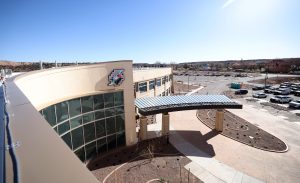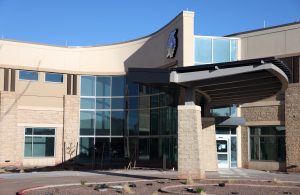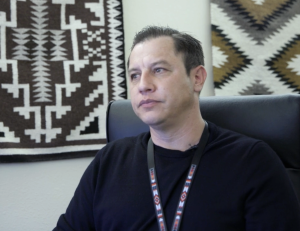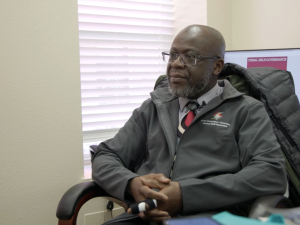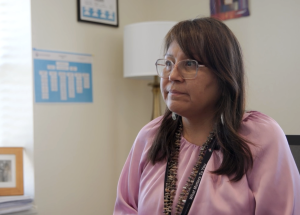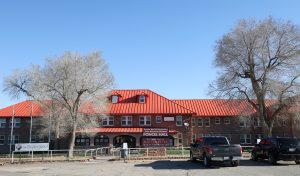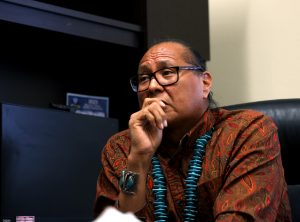- Slug: BC-CNS-Sage Memorial Hospital. 2,560 words.
- 8 photos available (thumbnails, captions below).
- Video & embeddable map available.
By Mia Milinovich
Cronkite News
GANADO – Desert stretches out around the little town of Ganado, which sits in the western part of the 27,000 square miles of the Navajo Nation.
Ganado is home to Sage Memorial Hospital, a Native-managed comprehensive health care system serving thousands of people in surrounding Navajo communities. The medical facility has operated out of its current facilities since 1930. Back then, the outpatient building, Poncel Hall, was home to the first Native American nursing school.
Now, 93 years later, Sage Memorial Hospital has built a 95,614-square-foot state-of-the-art hospital that is more than twice the size of the original hospital and will significantly increase patient capacity.
This ambitious endeavor aspires to provide better, more advanced health care to the Navajo Nation, but equally important is Sage Memorial’s mission to incorporate and honor the traditions of the Diné, the name that Navajo people use for themselves.
The hospital’s core values have been kept in the Diné language: bee łá’í ‘dlį, meaning togetherness and unity; hodílzin, meaning sacred; hózhó meaning beauty and balance; and ił’ílį, meaning respect.
Navajo Health Foundation – Sage Memorial Hospital is a private nonprofit corporation governed by an all-Navajo board of directors. The new facility is entirely self-funded by Sage Memorial Hospital and is slated to open this fall.
Melinda White, the hospital’s CEO, anticipates enormous benefits to the Navajo community.
“We want to be the best rural health facility,” White said. “The space we’re currently at is very tight, and we’re not able to see as many patients as we would like. And in the new building, because there’s a lot more space, we’re able to have a higher patient volume.”
Community care and local impact
There are 12 health care facilities run by the Indian Health Service (IHS) within the Navajo Nation, but some Navajo residents must travel 50 miles or more to reach basic health services, and specialized services are even more scarce.
Dr. Kenneth Anaeme, chief medical officer at Sage Memorial Hospital, said the nearest hospitals able to offer specialized care are in Albuquerque and Flagstaff.
“If you have someone who’s sick enough to require advanced care, now you’re talking about a two-and-a-half-hour drive to the nearest tertiary center that can care for that patient,” Anaeme said. “One of the issues we have is just the lack of specialized treatment capabilities here at Sage. So, that was causing a lot of distress for families.”
Anaeme said Sage Memorial can currently treat some primary health conditions such as diabetes, influenza, urinary tract infections, pneumonia, traumatic injury, alcoholism and more.
“Health care should be efficient, easily accessible,” Anaeme said. “It should be evidence-based, and it should be patient-centered. … If we’re trying to make the health care of our population efficient, not having delays in treatment, we need to have facilities that are state-of-the-art and that can accommodate things like telemedicine, the treatment of a patient at the source, rather than having to rely on transportation to another place.”
White said the move from the old cramped facility with outdated equipment to the new state-of-the-art facility will be a time warp. “We’re going from one place to another, where everything is going to be literally electronic. It’ll be very different, very, very different for us.”
White got her start in the medical field at Sage Memorial many years ago.
“I actually grew up in Albuquerque, and at one point in my life, I used to say, ‘I want to be a medicine woman,’” White said. “When I was very young and when I moved back to the reservation, I applied at Sage Memorial Hospital and started off as a medical records clerk.”
White was one of 10 students accepted to a nursing program at Northern Arizona University, and went on to work as a nurse in infection control. After learning hospital administration through various mentorships, White went back to Sage Memorial, drawn by its community-driven mission.
“How can we actually put those two together,” White said, “and create this hospital that accepts the traditional values, accepts the traditional aspects of it, and at the same time provides the Western medicine side.”
The new hospital has generated excitement in surrounding communities. Delores Noble, 66, a resident of the Steamboat community, approximately 20 miles from Ganado, received care at Sage Memorial for years, then took on a role on the hospital’s board of directors.
Noble currently gets physical therapy at Sage Memorial for piriformis syndrome, a condition in which a muscle in the buttocks spasms and causes pain, and she gets in-house dental care. Most recently, she’s used the new cardiology services for concerns about heart palpitations.
Noble is satisfied with her care at Sage Memorial but said the lack of privacy in the small facility is a concern. The current emergency department does not have private rooms; instead, patients share one room, divided into sections by curtains.
“We don’t have privacy, so it’s really embarrassing to hear conversations from the other patients, just a curtain away,” Noble said.
In the new facility, there will be 12 exam rooms in the ER, giving patients privacy and space.
The construction of the new facility is visible from Highway 264, a road that many community members use daily, according to Noble. She said she’s heard positive reactions to the prospect of the new medical facility.
“You can see, you know, the beginnings and the walls, as the steel beams went up,” Noble said. “They saw it taking shape. You have that hope. You have that sense of, ‘Oh, we can’t wait to see our new hospital.’ It’s something that has been talked about, and it’s finally coming true.”
Recent changes
A key issue Sage Memorial faces is limited care capabilities. Any time a patient has a critical care issue the hospital cannot address, the patient is flown to the nearest facility that can provide that service, often in Flagstaff or in the Valley, hours away from family members and their community.
In developing the new hospital, Anaeme and the medical team conducted a survey to determine what services were needed to keep patients from having to go off-site for additional care.
“We figured out that critical care services, cardiology services, general surgery services, those were probably our top three reasons for sending patients out,” Anaeme said. “We decided to tackle them one at a time. General surgery services are somewhat not conducive to telemedicine, right? So that left us dealing with the other two.”
Anaeme first established a contract with a cardiology provider who was able to see patients weekly via telemedicine. According to Anaeme, after seeing the work being done at Sage Memorial Hospital, the provider was inspired to switch to a hybrid practice, coming in person once a month to see patients. Before, the hospital could not offer advanced cardiology tests, but now it can provide in-house echocardiograms and stress tests.
As for critical care, Anaeme introduced the use of telemedicine carts.
“The critical care remains telemedicine because the critical care providers are out of state,” Anaeme said. “But they’re able to beam in through advanced technology that we have with our telemedicine carts, that are actually used to see patients. They can provide all the diagnostic testing we want.”
New facility and services
The new two-story building is nearing the final stages of construction.
Jarom Prows, the hospital’s director of facilities, shared its progress as of April 10.
“I would say we are between 95 and 98% complete,” Prows said. “Final paint has gone down, carpets, flooring, all the finishes are there. We are starting to do our punch walks … you look for minor imperfections and call those out, to have a contractor fix them.”
The new facility is full of technologically advanced equipment that staff will need to be trained to use. Other new services will include an obstetrics and labor and delivery ward, women’s health services, orthopedics, general surgery and an expanded intensive care unit with four beds.
Prows said the team did not cut any corners in procuring high-grade equipment.
“We’re getting all brand-new equipment, for the most part,” Prows said. “We have a new X-ray machine, CT machine, mammography machine. We have really fancy, state-of-the-art OR booms.”
The new hospital grounds will also house an optometry office, 16 dental chairs and a dedicated pediatric clinic. The team hopes the additional health care services will limit the amount of travel patients need to do.
Project struggles and barriers
The project was originally set to be completed in November 2023, but unforeseen delays have complicated construction and the new prospective opening date is October 2024.
Prows explained how they had to navigate labor restrictions.
“There are laws and regulations in place to help keep our people here on the rez,” Prows said. “We have this law, the NPEA, which requires us to hire Navajo first, hire quality Navajo candidates, and then you can get somebody else.”
The Navajo Preference in Employment Act, known as NPEA, was enacted to “lessen the Navajo Nation’s dependence upon off-reservation sources of employment, income, goods and services.” Prows said the law still applies, even though the new Sage Memorial Hospital is on private property.
“We still reside within the boundaries of the Navajo Nation, so we still have to abide by the rules and regulations,” Prows said. “Because of that issue, the project slowed way down. They had to advertise, they had to pull their workforce out and supplement it with the Navajo workforce.”
The most notable delay came following a 2019 traffic study requested by the Arizona Department of Transportation, which estimated that the project would increase Ganado’s growth by 14% by 2027. The result: Two new traffic lights along Highway 264 that would cost over $6.1 million, and would be taken out of the hospital’s budget.
“We tried working with our legislators,” White said. “We went down and visited with several senators, several representatives, trying to ask if they could help us with funding because, again, we are a health care facility, and our business is health care. Not roads.”
Prows said the two new traffic lights will be the first ones in Ganado.
“Highway 264 is one of the major corridors here on Navajo,” Prows said. “It basically goes from Gallup all the way to Tuba City, almost from border to border of the rez. St. Michaels and Window Rock have some traffic lights, but there are no traffic lights here in Ganado.”
This budget cut postponed the construction of the hospital’s new dialysis center.
“That money there that we’ve invested into the traffic lights could have and should have been invested into a dialysis center that we’ve already had slated,” Prows said. “So we have a shell space at the new hospital, but we couldn’t build that out because that money had to go to the roads.”
Anaeme stressed the importance of accessible dialysis services within the new facility.
“Right now, the only option for treatment is to send them (patients) five-and-a-half-hours away to Phoenix,” Anaeme said. “They’re away from their family, and then eventually, when they get better, they make a trip all the way back here. If they require being in the hospital for an extended period, you may have family having to visit them in Phoenix for weeks at a time.”
Despite the project delays the stoplights have created, Prows acknowledged that “it’s the best for the community.”
“It does help create a safety corridor here on 264, but that was one of those unexpected things that kind of came out of left field that we had to adapt and adjust to,” he said.
Staffing in rural settings
Staffing is another prominent struggle the Sage Memorial team faces. According to Dr. Richard Laughter, a psychiatrist and member of the hospital’s behavioral health team, providers cycle through the Navajo Nation at a rapid rate.
“Right when you get to know your doctor, your counselor or your psychiatrist, they’re gone,” Laughter said. “After six months to a year. Maybe someone will stay a little bit longer, but that’s very rare.”
To help mitigate this issue, Prows and the construction team looked into providing on-site housing options.
“Home ownership is very difficult. So in order for us to get providers to come and treat our patients, we have to be able to provide housing,” Prows said. “We built a 26-unit, multifamily apartment building over there, and we’re supposed to be building two more.”
The apartment complex is on the same grounds as the new facility.
Anaeme pointed out that providers are required to work at the “top of their license,” meaning they have to make many difficult decisions themselves due to the remote nature of their service.
Anaeme discussed some misperceptions about rural health care that impact the number of providers choosing to work in a remote area.
“Some people do tend to have an erroneous impression that being in a place like this, perhaps your medical practice will not be as advanced,” Anaeme said. “Maybe they might think that they may have fewer opportunities to see some of the big diseases as compared to if they were practicing, for example, in Phoenix.”
Anaeme is closely involved in the hiring process for new staff and has been developing recruitment plans to increase the number of staff on hand.
“For some, the rural area is off-putting so there’s certainly a challenge,” Anaeme said. “We do try to go to places. We try to go to the residency programs, to recruit for the area.”
In Anaeme’s experience, word of mouth is a powerful tool in growing a strong staff of providers willing to tackle challenges in rural health care. He is originally from Nigeria and completed his residency in internal medicine and pediatrics at the University of Illinois.
After relocating to Arizona in 2002, working in hospitalist medicine and entering private practice, Anaeme heard about Sage Memorial through a colleague. Now, as chief medical officer, he hopes to use word of mouth to grow the staff for the new facility.
Resilience
Many staff members at Sage Memorial noted both the community’s dedication and their team’s perseverance, all motivated to make a significant contribution to health care in the Navajo Nation.
“It’s really a question of resilience, right?” Anaeme asked. “Resilience in the community. I’m the only non-Navajo member of the executive management team right now, although I have been formally adopted by the board chairwoman into one of her clans. But I’m so impressed and honored to be a part of the Navajo community, trying to get first-class health care to its population.”
For many team members involved in this project, the new hospital not only impacts the community at large but will help provide their own families and loved ones with the advanced care they need. Prows touched on the new hospital’s positive impact on his own family.
“A lot of them kind of prolong their care or push off their care because of the dated hospital,” Prows said. “Instead, they go to Gallup or they go to Ford when, in reality, this should be their home hospital.”
The new hospital is an improvement from the nearly 100-year-old facility, one that will impact access and quality of care for the Diné people.
“This was and is one of the pioneers of health care here on Navajo,” Prows said. “Just being able to continue that legacy is really rewarding.”
